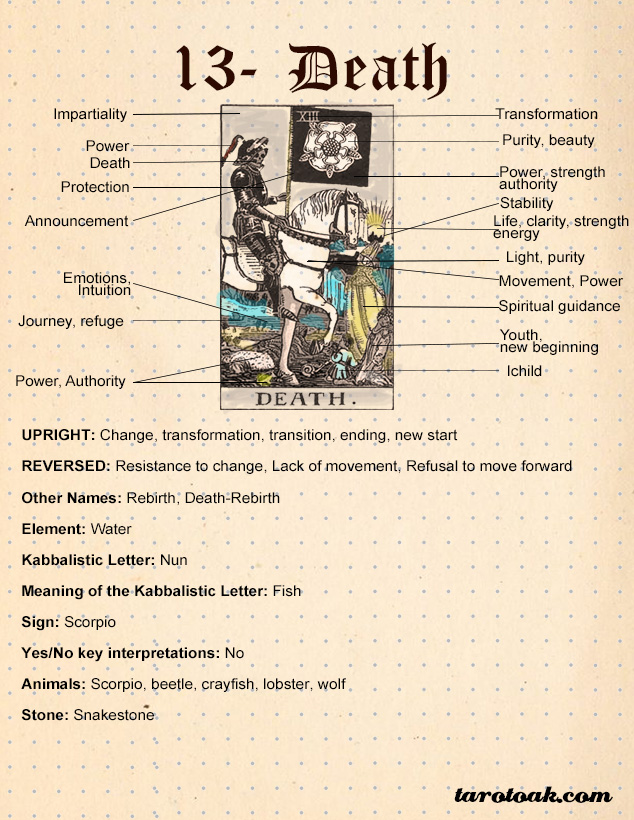The Death tarot card, often portrayed with a skeletal figure, is one of the most misunderstood and misrepresented cards in the tarot deck. Its striking imagery typically evokes shock and fear, yet its meanings delve into profound interpretations that transcend mere endings. Engaging with the notion of death can trigger an array of emotional responses, but the symbolism of the Death card is multifaceted, encapsulating transformation, renewal, and the inevitability of change.
At first glance, the Death card seems to denote finality—the cessation of life, the conclusion of a chapter. However, this superficial reading neglects the card’s deeper implications. In the context of the tarot, death does not signify a physical demise; rather, it heralds a transitory phase, prompting a reevaluation of personal circumstances and beliefs. It encapsulates the idea that to embrace new beginnings, one must first let go of what no longer serves them. Thus, the Death card compels individuals to confront their fears surrounding change and mortality.
One might ponder why the concept of death captivates so many. After all, it is a universal experience, yet one often shrouded in taboo. Our collective fascination with death is mirrored in literature, art, and culture, where it serves as a powerful narrative device. The Death card acts as a potent reminder of the impermanence of existence, urging individuals to reflect on their lives and the transient nature of their experiences. Its stark imagery becomes a catalyst for introspection, prompting an exploration of how we navigate the complexities of life and death.
In tarot readings, the Death card often crops up during periods of significant personal evolution or existential questioning. When drawn, it may signal the closure of a phase—perhaps the end of a relationship, a shift in career, or a reevaluation of one’s priorities. Such changes, while daunting, are inherently tied to the cycle of rebirth. Each ending paves the way for new possibilities, underscoring the idea that life is a continuous loop of transformation.
The symbolism in the Death card extends beyond mere endings. Illustrated with the figure of a skeleton, often accompanied by various symbolic elements like a rising sun or blooming flowers, it communicates vitality amidst desolation. The skeleton signifies the shedding of the physical form, focusing instead on the notion of essence and spirit. The rising sun indicates that after every ending, light prevails. Meanwhile, blooming flowers act as a metaphor for rebirth, implying that from death springs new life and opportunities.
Moreover, in psychological terms, the Death card evokes a confrontation with the shadow self—the parts of us we often deny or suppress. It challenges individuals to embrace their fears and anxieties, making room for healing and growth. Acknowledging the aspects of life that require transformation can be a daunting task, yet it is precisely this journey into the self that ultimately leads to enlightenment. By leaning into the discomfort of change, one can achieve a greater understanding of their true self.
Notably, the Death card’s appearance in a reading does not have to elicit trepidation. It serves as a compelling invitation to embrace the cyclical nature of existence. As seasons change and life ebbs and flows, surrendering to the inevitability of change can foster resilience and adaptability. This perspective allows individuals to view endings not as irreparable losses but as opportunities for renewal.
In a broader metaphorical sense, the fascination with the Death card can be seen as a reflection of the human condition. Societies have long grappled with existential questions, seeking meaning in life and, ultimately, in death. The prevalence of the Death card in popular culture—from literature to film—demonstrates humanity’s relentless pursuit of understanding the enigmatic cycle of life. This inquiry leads to philosophical discussions about legacy, destiny, and the nature of existence itself.
Furthermore, many cultures have developed rituals and traditions surrounding death that honor this transition, emphasizing the importance of remembrance and mourning. These practices reveal the societal inclination to grapple with mortality, showcasing the human need to ascribe meaning to loss. They reflect a profound truth—the end of one journey often serves as the fulcrum for another. Consequently, the Death card embodies this duality, symbolizing not just the conclusion but the beginning of transformations that may arise from profound experiences.
In conclusion, the Death tarot card serves as a powerful reminder of the richness embedded in life’s cyclical nature. While it can initially evoke fear and uncertainty, its deeper implications advocate for acceptance and understanding. By embracing the transformations it represents and acknowledging the inevitability of change, individuals may uncover the potential that lies within the edges of uncertainty. Thus, rather than seeing it as an omen of despair, we can choose to interpret the Death card as a herald of rebirth and renewal, ushering in new opportunities and perspectives on our journey through life.









Leave a Comment